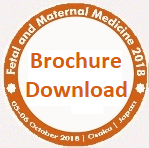
Michael J Sinosich
Sonic Healthcare, Australia
Title: State of art in non-invasive prenatal screening
Biography
Biography: Michael J Sinosich
Abstract
The urge to procreate has spawned IVF-ART industry and similarly, the desire to know (prenatally) the wellbeing of your unborn child has generated prenatal diagnostic services. Non-Invasive Prenatal Screening (NIPS) includes proteomic, molecular and ultrasonographic testing modalities, applied prenatally to identify a subset of obstetric population assessed to be at increased risk for disorder being screened. Through recent technical advances, quantitation of low abundance DNA has enabled non-invasive prenatal fetal chromosome enumeration. Screening for feto-placental wellbeing, includes ALL current screening modalities: Proteomic (PAPP-A, FbhCG, AFP, PlGF), ultrasonography (NT), extracellular (cf) and intracellular (genomic) DNA. Prior to any definitive intervention, patients with positive screening result should be counseled to seek confirmatory diagnostic testing. Combination of feto-placental biochemistry with ultrasonographic biometry can provide Trisomy 21 detection rate of 92.9%. Whilst not matching performance of cfDNA (DR=99.9%), clinical application of combine first trimester biochemistry extends beyond screening just for Trisomy 21. Fetal triploidy, which is undetectable by many cfDNA algorithms, presents with median Nuchal Translucency (NT) of 1.35 mm. However, median PAPP-A (0.06 MoM) and FbhCG (0.24 MoM) clearly signal a clinical situation warranting further investigation. Inclusion of PlGF has introduced another dimension to screening because now we can simultaneously screen for fetal and maternal wellbeing, such as, pre-eclampsia. Recent developments allow isolation of fetal-placental cells, which can be applied for chromosome enumeration and for Whole Genome Sequencing (WGS). Cellular targets include Nucleated Fetal Red Blood Cells (NFRBC), Mononucleated Cytotrophoblast (CT) and Polynucleated Syncytiotrophobslast (SCT) cells. After initial enrichment, fetal cell isolation is achieved by laser dissection. Whilst providing a pure fetal cell, this technology is labor intensive and hence, not yet applicable to population based screening. Over the past two decades, non-invasive prenatal screening has progressed from screening for targeted fetal abnormalities to combined prenatal assessment of feto-maternal wellbeing and finally, to prenatal fetal whole genome sequencing.

